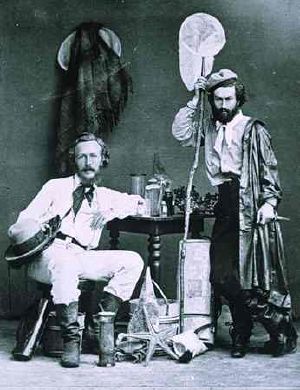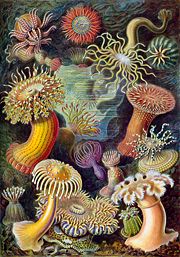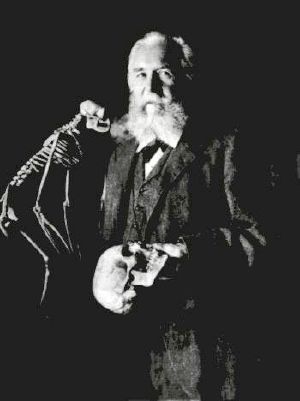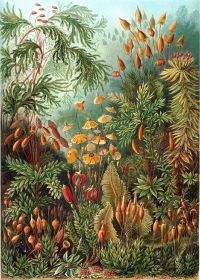Ernst Haeckel


Ernst Heinrich Philipp August Haeckel (February 16, 1834 — August 9, 1919),[1] also written von Haeckel, was an eminent German biologist, naturalist, philosopher, physician, professor and artist. Ernst Haeckel named thousands of new species (see below), mapped a genealogical tree relating all life forms, and coined many terms in biology, including phylum, phylogeny, ecology and the kingdom Protista (details below). Haeckel promoted Charles Darwin's work in Germany and developed the controversial "recapitulation theory" claiming that an individual organism's biological development, or ontogeny, parallels and summarizes its species' entire evolutionary development, or phylogeny: "ontogeny recapitulates phylogeny" (see below).
The published artwork of Haeckel includes over 100 detailed, multi-color illustrations of animals and sea creatures (see: Kunstformen der Natur, "Artforms of Nature"). As a philosopher, Ernst Haeckel wrote Die Welträthsel (1895-1899, in English, The Riddle of the Universe, 1901), the genesis for the term "world riddle" (Welträthsel); and Freedom in Science and Teaching (1877, English 1879, ISBN 1-4102-1175-4) to support teaching evolution.
Research
Haeckel was a zoologist, an accomplished artist and illustrator, and later a professor of comparative anatomy. He was one of the first to consider psychology as a branch of physiology. He also proposed many now ubiquitous terms including "phylum" and "ecology." His chief interests lay in evolution and life development processes in general, including development of nonrandom form, which culminated in the beautifully illustrated Kunstformen der Natur (Art forms of nature).
Haeckel advanced the "recapitulation theory" which proposed a link between ontogeny (development of form) and phylogeny (evolutionary descent), summed up in the phrase "ontogeny recapitulates phylogeny". He supported the theory with embryo drawings that have since been shown to be oversimplified and in part inaccurate, and the theory is now considered an oversimplification of quite complicated relationships. It is thought by some critics of Haeckel, particularly creationists, that Haeckel deliberately faked the images to get more support for his ideas. Haeckel introduced the concept of "heterochrony", which is the change in timing of embryonic development over the course of evolution.
Haeckel was also known for his "biogenic theory", in which he suggested that the development of races paralleled the development of individuals. He advocated the idea that "primitive" races were in their infancies and needed the "supervision" and "protection" of more "mature" societies.
Haeckel extrapolated a new religion or philosophy called "monism" from evolutionary science. In Haeckel's view of monism, which postulates that all aspects of the world form an essential unity, all economics, politics, and ethics are reduced to "applied biology." [2] Haeckel's writings and lectures on monism were later used to provide scientific (or quasi-scientific) justifications for racism, nationalism, and social Darwinism.[2]
A quote from Haeckel:
- "In order to be convinced of this important result, it is above all things necessary to study and compare the mental life of wild savages and of children. At the lowest stage of human mental development are the Australians, some tribes of the Polynesians, and the Bushmen, Hottentots, and some of the Negro tribes.
- In many of these languages there are numerals only for one, two, and three: no Australian language counts beyond four. Very many wild tribes can count no further than ten or twenty, whereas some very clever dogs have been made to count up to forty and even beyond sixty."
- –Ernst Haeckel, The History of Creation (1868/1883), pp. 362, 363.
Biography

Ernst Haeckel was born on February 16, 1834, in Potsdam (then part of Prussia). [3] In 1852, Haeckel completed studies at Cathedral High School (Domgymnasium) of Mersburg.[3] He then studied medicine in Berlin, particularly with Albert von Kölliker, Franz Leydig, Rudolf Virchow (with whom he later worked briefly as assistant), and with anatomist-physiologist Johannes Müller/Mueller (1801-1858).[3] In 1857, Haeckel attained a doctorate in medicine (M.D.), and afterwards he received a license to practice medicine. The occupation of physician appeared less worthwhile to Haeckel, after contact with suffering patients.[3]
Haeckel studied under Carl Gegenbaur at the University of Jena for three years, earning a doctorate in zoology,[3] before becoming a professor of comparative anatomy at the University of Jena, where he remained 47 years, from 1862-1909. Between 1859 and 1866, Haeckel worked on many "invertebrate" groups, including radiolarians, poriferans (sea sponges) and annelids (segmented worms).[2] During a trip to the Mediterranean, Haeckel named nearly 150 new species of radiolarians.[2] "Invertebrates" provided the data for most of his experimental work on evolutionary development, leading to his "law of recapitulation." [2] Haeckel named thousands of new species from 1859 to 1887. [4]
In 1866 to 1867, Haeckel made an extended journey to the Canary Islands and during this time, Haeckel met with Charles Darwin, Thomas Huxley and Charles Lyell.[3]
In 1867, Haeckel married Agnes Huschke. Their son Walter was born in 1868, their daughter Elizabeth in 1871, and their daughter Emma in 1873.[3]
In 1869, Haeckel traveled as a researcher to Norway, in 1871 to Dalmatien, and in 1873 to Egypt, Turkey, and to Greece.[3]
Haeckel was also a free-thinker who went beyond biological studies, dabbling in anthropology, psychology, and cosmology.[2] Haeckel's speculative ideas and possible fudging of data or diagrams, plus the lack of empirical support for many of his ideas, have tarnished his scientific credentials; however, Ernst Haeckel remained a very popular figure in Germany and was considered a hero by many of his countrymen.[2]
Haeckel was a flamboyant figure. He sometimes took great (and non-scientific) leaps from available evidence. For example, at the time that Darwin first published On the Origin of Species by Means of Natural Selection (1859), no remains of human ancestors had yet been found. Haeckel postulated that evidence of human evolution would be found in the Dutch East Indies (now Indonesia), and described these theoretical remains in great detail. He even named the as-of-yet unfound species, Pithecanthropus alalus, and charged his students to go find it. (Richard and Oskar Hertwig were two of Haeckel´s many important students.)
One student did find the remains: a young Dutchman named Eugene Dubois went to the East Indies and dug up the remains of Java Man, the first human ancestral remains ever found. These remains originally carried Haeckel's Pithecanthropus label, though they were later reclassified as Homo erectus.
Although Haeckel's ideas are important to the history of evolutionary theory, and he was a competent invertebrate anatomist most famous for his work on radiolaria, many speculative concepts that he championed are now considered incorrect. For example, Haeckel described and named hypothetical ancestral microorganisms that have never been found. His concept of recapitulation has been disputed in the form he gave it (now called "strong recapitulation"). Haeckel did not support natural selection, rather believing in a Lamarckian inheritance of acquired characteristics (Darwin considered both of these paths for evolution viable). [5] It has also been claimed (Richardson 1998) that Haeckel's drawings of 1874 were substantially fabricated; [6] [7] however, it was later claimed that "there is evidence of sleight of hand" on both sides of the feud between Haeckel and Wilhelm His (Richardson & Keuck 2001).[7] There were multiple versions of the embryos drawings, and Haeckel himself rejected the claims of fraud.[7] [8] The controversy involves several different issues (see more details at: recapitulation theory).
Although best known for "recapitulation theory" with the famous dictum "ontogeny recapitulates phylogeny," Haeckel also coined many words commonly used by biologists today, such as phylum, phylogeny, ecology ("oekologie"),[4] and proposed the kingdom Protista.[3]
Haeckel also stated that "politics is applied biology",[2] a quote used by various Nazis. The Nazi party used not only Haeckel's quotations, but also Haeckel's broader philosophy of "Monism," which they used as justification for racism, nationalism and social Darwinism.[2]
In 1909, Haeckel retired from teaching, and in 1910 he withdrew from the Evangelist church.[3] Haeckel's wife, Agnes, died in 1915, and Ernst Haeckel became substantially more frail, with a broken leg (thigh) and broken arm.[3] He sold the mansion Medusa ("Villa Medusa") in 1918 to the Carl Zeiss foundation.[3] Ernst Haeckel died on August 9, 1919.
In the U.S., Mount Haeckel, a 13,418-ft (4,090 m) summit in the Eastern Sierra Nevada, overlooking the Evolution Basin, and another Mount Haeckel, a 2,941-m (9,649-ft) summit in New Zealand, are named in honor of Ernst Haeckel, as is the asteroid 12323 Häckel.
The Ernst Haeckel house ("Villa Medusa") in Jena, Germany contains a historic library.
Publications
Haeckel's literary output was extensive, working as a professor at the University of Jena for 47 years, and even at the time of the celebration of his sixtieth birthday at Jena in 1894, Haeckel had produced 42 works with nearly 13,000 pages, besides numerous scientific memoirs and illustrations. [9]
Haeckel's monographs include: Radiolaria (1862), Siphonophora (1869), Monera (1870) and Calcareous Sponges (1872), as well as several Challenger reports: Deep-Sea Medusae (1881), Siphonophora (1888), Deep-Sea Keratosa (1889), and another Radiolaria (1887), the last being illustrated with 140 plates and enumerating over four thousand (4000) new species.[9]
Among his many books, Ernst Haeckel wrote General Morphology (1866); Natürliche Schöpfungsgeschichte (1868, in English, The Natural History of Creation reprinted 1883); Freie Wissenschaft und freie Lehre (1877, in English, Freedom in Science and Teaching) in reply to a speech in which Virchow objected to the teaching of evolution in schools, on the grounds that evolution was an unproven hypothesis;[9] Die systematische Phylogenie (1894, "Systematic Phylogeny"), which has been considered as his best book,[9] Anthropogenie (1874, 5th and enlarged edition 1903), dealing with the evolution of man; Die Welträthsel (1895-1899, also spelled Die Welträtsel ("world-riddle"), in English The Riddle of the Universe, 1901);[9] Über unsere gegenwärtige Kenntnis vom Ursprung des Menschen (1898, translated into English as The Last Link, 1808); Der Kampf um den Entwickelungsgedanken (1905, English version, Last Words on Evolution, 1906); Die Lebenswunder (1904, "Wonder of Life"), a supplement to the Riddle of the Universe; also books of travel, such as Indische Reisebriefe (1882, "Travel notes of India") and Aus Insulinde: Malayische Reisebriefe (1901, "Travel notes of Malaysia"), the fruits of journeys to Ceylon and to Java; Kunstformen der Natur (1904, Artforms of Nature), with plates representing detailed marine animal forms; and Wanderbilder (1905, "travel images"), with reproductions of his oil-paintings and water-color landscapes.[9]
See also
- Stephen Jay Gould - biologist.
- Alfred Ploetz - on eugenics and racial hygiene.
Notes
- ↑ "Ernst Haeckel - Britannica Concise" (biography), Encyclopædia Britannica Concise, 2006, Concise.Britannica.com webpage: CBritannica-Haeckel.
- ↑ 2.0 2.1 2.2 2.3 2.4 2.5 2.6 2.7 2.8 "Ernst Haeckel" (biography), UC Berkeley, 2004, webpage: BerkeleyEdu-Haeckel.
- ↑ 3.00 3.01 3.02 3.03 3.04 3.05 3.06 3.07 3.08 3.09 3.10 3.11 "Ernst Haeckel" (article), German Wikipedia, October 26, 2006, webpage: DE-Wiki-Ernst-Haeckel: last paragraph of "Leben" (Life) section.
- ↑ 4.0 4.1 "Rudolf Steiner and Ernst Haeckel" (colleagues), Daniel Hindes, 2005, DefendingSteiner.com webpage: Steiner-Haeckel.
- ↑ Ruse, M. 1979. The Darwinian Revolution. Chicago: University of Chicago Press.
- ↑ Michael K. Richardson. 1998. "Haeckel's embryos continued." Science 281:1289, quoted in NaturalScience.com webpage Re: Ontogeny and phylogeny: A Letter from Richard Bassetti; Editor's note.
- ↑ 7.0 7.1 7.2 "Haeckel's embryos" (of drawings, with detailed quotes by Haeckel & others), Tony Britain, 2001, AntiEvolution.org webpage: AE-myths.
- ↑ "The Controversy over Evolution in Biology Textbooks" (Texas, Textbooks and Evolution), Dr. Raymond G. Bohlin (President), Probe Ministries, 2003, Probe.org webpage: ProbeOrg-Textbook-Controversy: mentions Haeckel drawings, peppered moth story and Cambrian explosion.
- ↑ 9.0 9.1 9.2 9.3 9.4 9.5 "Biography of Ernst Heinrich Haeckel, 1834-1919" (article), Missouri Association for Creation, Inc., based on 1911 Britannica, webpage: Gennet-Haeckel: life, career & beliefs.
ReferencesISBN links support NWE through referral fees
- Charles Darwin (1859). On the Origin of Species (by Means of Natural Selection). London: John Murray.
- Charles Darwin (2003 edition). The Origin of Species (with introduction by Julian Huxley). Signet Classics. ISBN 0-451-52906-5.
- Ernst Haeckel, Freedom in Science and Teaching (1879), reprint edition, University Press of the Pacific, February 2004, paperback, 156 pages, ISBN 1-4102-1175-4.
- Ernst Haeckel, The History of Creation (1868), translated by E. Ray Lankester, Kegan Paul, Trench & Co., London, 1883, 3rd edition, Volume 1.
- Ernst Haeckel, Kunstformen der Natur ("Artforms of Nature"), 1904, (from series published 1899-1904): over 100 detailed, multi-color illustrations of animals and sea creatures.
- Ernst Haeckel, The Riddle of the Universe (Die Weltraetsel, 1895-1899), Publisher: Prometheus Books, Buffalo, NY, 1992, reprint edition, paperback, 405 pages, illustrated, ISBN 0-87975-746-9.
- Richard Milner, The Encyclopedia of Evolution: Humanity's Search for Its Origins, Henry Holt, 1993.
- Michael K. Richardson, "Haeckel's embryos continued" (article), Science Volume 281:1289, 1998.
- Richardson, M. K. & Keuck, G. (2001) "A question of intent: when is a 'schematic' illustration a fraud?," Nature 410:144 (vol. 410, no. 6825, page 144), March 8, 2001.
- M. Ruse, The Darwinian Revolution. Chicago: University of Chicago Press, 1979.
Further reading
- Art Forms from the Ocean: The Radiolarian Atlas of 1862, by Ernst Haeckel, Prestel Verlag, 2005, ISBN 3-7913-3327-5.
- Works by Ernst Haeckel. Project Gutenberg.
- Richardson, Michael K., "Haeckel, embryos, and evolution," Science Vol. 280, no. 5366 (May 15, 1998) p. 983, 985-986.
External links
- Marine Biological Laboratory Library - An exhibition of material on Haeckel, including background on many Kunsformen der Natur plates
- University of California, Berkeley - Ernst Haeckel biography
- Ernst Haeckel – Evolution's controversial artist. A slide-show essay about Ernst Haeckel.
- Kunstformen der Natur, Wikimedia Commons: over 100 detailed animal drawings.
- Kunstformen der Natur, scanned (from biolib.de Stuebers Online Library)
- PNG alpha-transparencies of Haeckel's "Kustformen der natur"
- Proteus - An animated documentary film on the life and work of Ernst Haeckel
- Ernst Haeckel Haus and Ernst Haeckel Museum in Jena
Credits
New World Encyclopedia writers and editors rewrote and completed the Wikipedia article in accordance with New World Encyclopedia standards. This article abides by terms of the Creative Commons CC-by-sa 3.0 License (CC-by-sa), which may be used and disseminated with proper attribution. Credit is due under the terms of this license that can reference both the New World Encyclopedia contributors and the selfless volunteer contributors of the Wikimedia Foundation. To cite this article click here for a list of acceptable citing formats.The history of earlier contributions by wikipedians is accessible to researchers here:
The history of this article since it was imported to New World Encyclopedia:
Note: Some restrictions may apply to use of individual images which are separately licensed.



